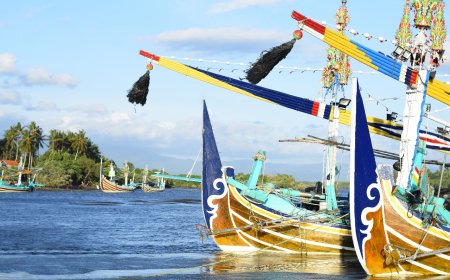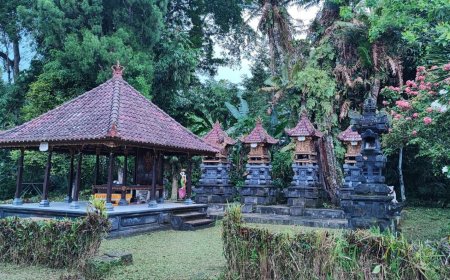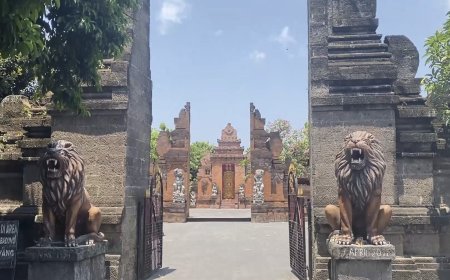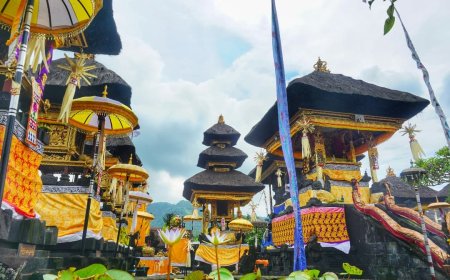History of Pura Kawitan Arya Kepakisan and Prince Nyuh Aya
The main focus of this article is a discussion of the history of Pura Kawitan Arya Kepakisan and the role of Arya Kepakisan in overcoming the rebellion and the resulting changes in Bali's government structure. In a historical journey full of intrigue, we will see how Arya Kepakisan was appointed Grand Governor and Dalem Sri Kresna Kepakisan became King of Sampranga I, while exploring its impact on social, cultural and political developments in Bali.
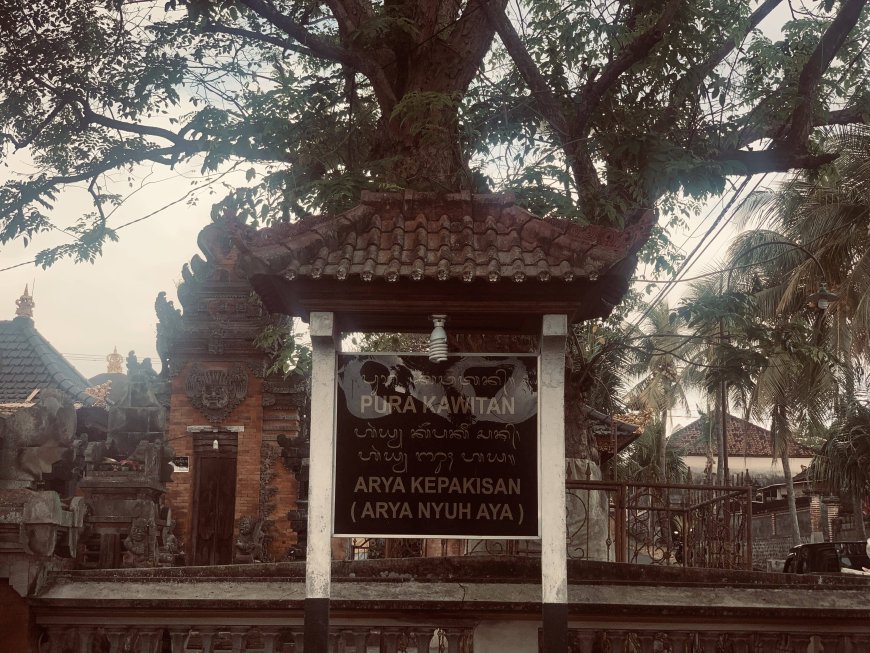
In the course of its long and intriguing history, the island of Bali has witnessed important events that formed the basis for profound changes in its government and the lives of its people. One of the striking chapters in the story is the conquest of Bali by Majapahit troops in 1352 AD, which was followed by attempts to suppress the rebellion of the Aga tribe on the island. The success of this mission elevated a figure named Arya Kepakisan to Grand Governor and confirmed Dalem Sri Kresna's position as King of Sampranga I. This article will discuss this event further and its influence on the subsequent historical development of Bali.
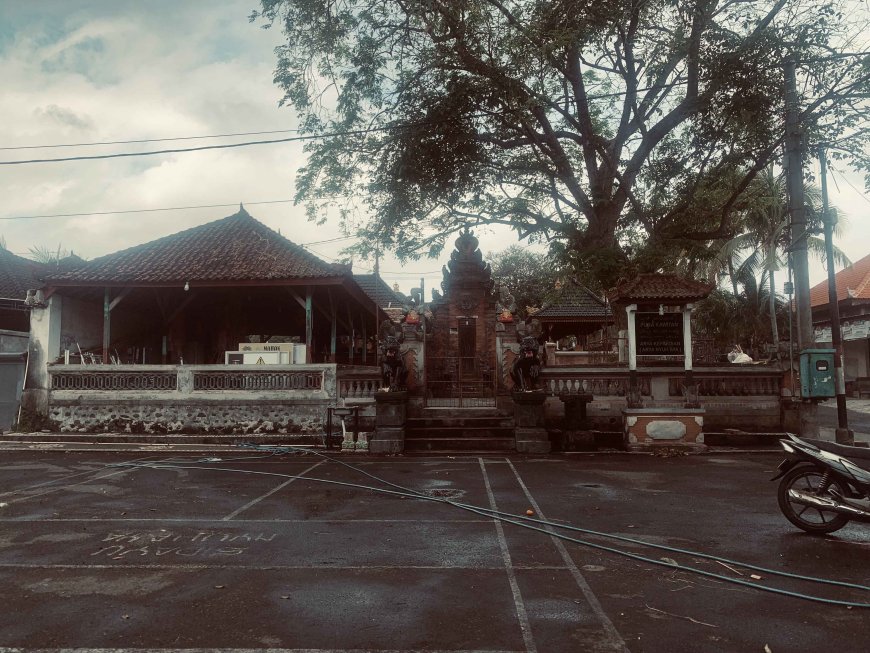
Pura Kawitan Arya Kepakisan (Sumber Photo: Koleksi Redaksi)
After the conquest of Bali, it was clear that rebellions continued to occur everywhere, because the Aga tribe population in Bali was dissatisfied with the Aryan government imposed on Bali. Based on Gajah Mada's orders, Arya Kepakisan arrived in Bali in 1352 AD. The King of Majapahit accompanied him to Dalem Sri Kresna Kepakisan to quell the rebellion in 39 Bali Aga villages. The rebellious Aga Bali villages were conquered one by one. After his success, he was appointed Grand Governor of the kingdom with Dalem Sri Kresna Kepakisan as King Sampranga I.
Dalem Sri Kresna Kepakisan bersthana (residence) in Samprangan. At the same time, Arya Kepakisan went southeast and came to a place where he found a large coconut (Nyuh Aya) being roasted. This place was chosen as a settlement which was later named NYUH AYA VILLAGE, to commemorate the discovery of the large coconut (Nyuh Aya). This place was also marked/cihna/stamped by Taru Agung or also called Taru Rangsana, which in East Java is often found in the form of a tree called the Angsana tree (Pterocarpus indicus). Sarang Agung is unique because its juice is blood red, like human blood. Because of its uniqueness, Taru was chosen to be the sign/cihna/Agung identity brought by Arya Kepakisan (Arya Nyuh Aya) from Pakis village. Here Arya Kepakisan (Arya Nyuh Aya) founded Merajan and later it became PURA KAWITAN after he died and rested at Pura Kawitan Arya Kepakisan (Arya Nyuh Aya).
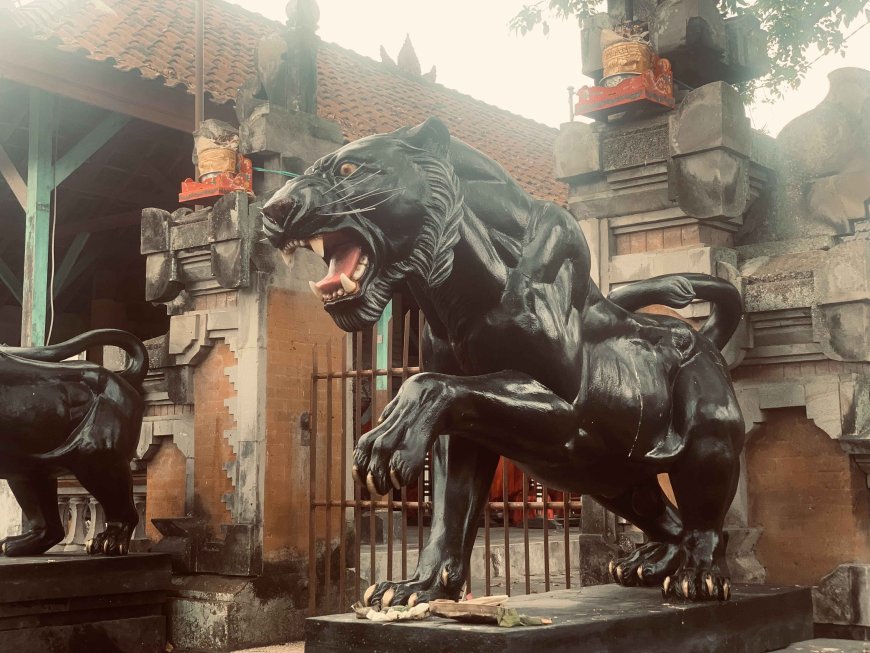
Pura Kawitan Arya Kepakisan Patung Macan Selem (Sumber Photo: Koleksi Redaksi)
During the reign of Dalem Sri Semara Kepakisan, there lived a Black Tiger (Macan Selem) in Blambangan (Banyuwangi) who was extremely cruel and powerful, causing disruption in the lives of the local people. Due to the severe disturbance caused by the Black Tiger (Macan Selem), Dalem sent Sri Semara Kepakisan Arya Kepakisan (Arya Nyuh Aya) as the ousted Patih Agung to Blambangan (Banyuwangi) with the mission of eliminating the Black Tiger (Macan Selem). Arya Nyuh Aya followed in the footsteps of Arya Kubo Badan, who had been pursuing the same mission for quite some time.
Prince Nyuh Aya successfully killed the tiger and presented its head as evidence to Dalem Sri Semara Kepakisan. Shortly after, Arya Kebon Badan arrived at Kebon Badan and announced that he had also slain the tiger. To avoid any misunderstandings, Dalem Sri Semara Kepakisan granted the same gift to Prince Nyuh Aya and Arya Kebon Badan. This gift took the form of a charter documenting the rights to honor and respect, as well as the procedures for ceremonies and life and death events for future generations.
As a form of gratitude for the services of Prince Nyuh Aya and Arya Kebon Jenazah, King Bali assigned them specific tasks. These tasks included Arya Kebon Badan receiving the responsibility of overseeing the Kahyangan Temple "Dalem Tugu," while Prince Nyuh Aya was entrusted with safeguarding the "Aji Purana." It was noted that every ceremonial procession at Pura Dalem Tugu must involve transporting the ceremonial items to Dalem Tugu for the ceremony. After the ceremonies were concluded, Prince Nyuh Aya became the guardian of the "Aji Purana." However, for reasons not specified, the "Aji Purana" is no longer present at Pura Dalem Tugu. Instead, the divine representation in the form of "Aji Purana" is now housed at the Kawitan Arya Kepakisan (Arya Nyuh Aya) Temple, located in Banjar Sidayu Nyuhaya, Takmung Village, Banjarangkan District, Klungkung Regency.
Additionally, in the event that the descendants of Arya Kepakisan (Arya Nyuh Aya) and Arya Kubon Body pass away, they have the tradition of wearing a di aben, adorned with nine colors of cotton, balai silunglung, kajang kawitan, balai ljuk tiga undag, and a representation of the adventure involving the black tiger (Macan Selem). The heirloom passed down to them is a blowpipe known as Ki Macan Guguh, which was originally used to kill the tiger in Blambangan. Furthermore, it is worth noting that the sacred words associated with this tradition are preserved in Pura Kawitan, and the first sentence spoken by Arya Kepakisan (Arya Nyuh Aya) is as follows: "Mulaning Carma Balilla Sri Arya Kepakisa, Arya Kediri de Jayasabha, Ari Aji de Jayabhaya, Erlanggia, Putu Kameswara de Dharma Wangsa."
In the Pura Kawitan language, the last verse spoken by Arya Kepakisan (Arya Nyuh Aya) is as follows: "Asak aoka Prince Nginte, Prince Nginte anis Sira Jaya Keta." This marks the conclusion of the war performance. Arya Kediri Jayasabha was the son of Arya Kepakisan. Alongside Arya Kepakisan, Arya Wang Bang, Arya Kenceng, Arya Delancang, Arya Belog, Arya Kudutan, as well as your Wang Bang, Tan Kober, Tan Kabur, Tan Mundur, and Arya Kutawaring, were appointed by Malih Arya Kepakisan.
Prince Nyuh Aya, masentane pepitu, pinih werde Petandakan, Satra, Pelangan, Akah, Kloping, Cacaran, Anggan were among those appointed. This is the reraja (narrative) of Kajang Maring Pemerajan Arya Nyuh Aya.
Pamencangah is very clear and implied that the pemerajan is in Nyuh Aya village, so it is called Pemerajan Arya Nyuh Aya, none other than Pemerajan Arya Kepakisan (Arya Nyuh Aya) and commemorates the village of Nyuh Aya. His son was also named Prince Nyuh Aya because he was born in Nyuh Aya village.
If you look at the description above, it is clear that when he first came to Bali, Arya Kepakisan occupied a place called Nyuh Aya Village. That's why she is called Arya Nyuh Aya. Arya Kepakisan or Arya Nyuh Aya has two sons, namely
1. Prince Nyuh Aya (born in Nyuh Aya village)
2. Prince Made Asak (born in Gelgel). Etc
There are quite a lot of descendants of Arya Kepakisan in Bali. To honor his ancestors as the former King of Kedir, his descendants in Bali agreed to give him the title Sri Nararya Kresna Kepakisan. According to Hindu concepts, every family who wants to build a yard or house must build a Parahyangan Pemerajan or Sanggah. As Arya Kepakisan (Arya Nyuh Aya), after living in the village of Nyuh Aya, he also built Pemerajan which is now Pura Kawitan after moksa and bershtana at Pura Kawitan Arya Kepakisan (Arya Nyuh Aya). Nyuhaya Village is believed to be the same as Banjar Sidayu Nyuhaya, Takmung Village, Banjarangkan District, Klungkung Administrative Regency, because the Taru Agung or Taru Rangsana which is used as a sign still stands and thrives in Kawitani Arya Kepakisan. (Arya Nyuh Aya) Temple. This is the "mind" or origin of all Prati Sentana Arya Kepakisan (Arya Nyuh Aya) in Bali.









